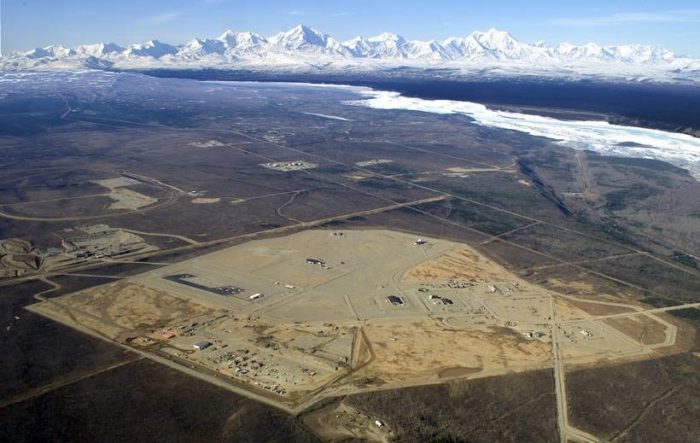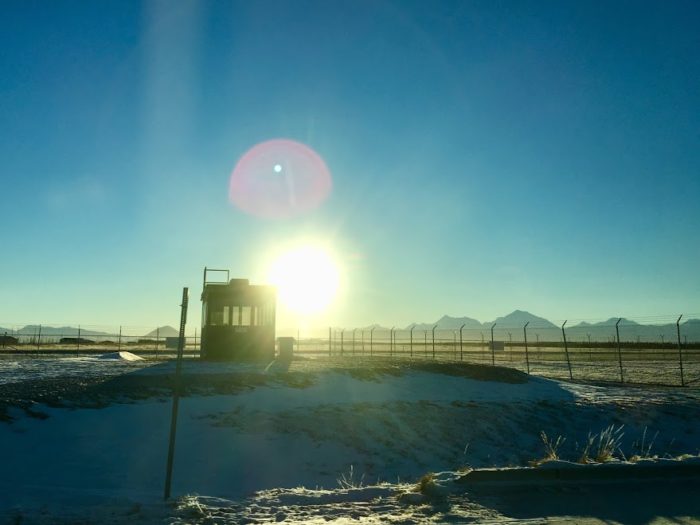wcag heading
by Daniel Wasserbly
wcag heading
With unprecedented access to the highly classified strategic nerve centers of U.S. Northern Command in Cheyenne Mountain, years of research, and dozens of exclusive interviews with normally inaccessible missile crews, author Daniel Wasserbly reveals the incredible true story behind the US Army’s elite missile defenders.

If, on the worst day imaginable, a nuclear-armed intercontinental ballistic missile were fired at the United States, the only possible defense would be to launch interceptors into space in an attempt to engage and destroy the incoming warhead. Those interceptors would be launched by US Army soldiers from silos at Fort Greely in Alaska, with help from a headquarters in Colorado and a global network of radars and satellites.
This massive undertaking – based on tens of billions of dollars’ worth of equipment – revolves around tiny Fort Greely, an army post twice abandoned by the US government.
New soldiers joining the US Army’s 49th Missile Defense Battalion at Greely mostly fly into Fairbanks, the closest town. The drive from Fairbanks down to Greely can be dangerous when ice and snow suddenly make the small road disappear. Twisting down Alaska Route 2, the hilly tree line to the road’s east is thick with conifers nearer to Fairbanks, but begins to thin out as the road meanders south. To the west, more tributaries and runoffs branch out from the Tanana River as the landscape flattens and gives way to subarctic tundra. On a clear day, when the road gets closer to Greely and turns past one of the few remaining hills, the snow-capped mountains of the Alaska Range suddenly frame the view in the windshield. This drive is often a new soldier’s first experience in Alaska.
Members of the battalion find themselves on a small army post, home to 205 soldiers and 40 interceptor missiles. The soldiers either guard the missile complex or man the five crews that would launch the interceptors to defend against a nuclear strike on the United States. It’s a lofty mission.
Soldiers and their families moving to Greely do what they always do before a new assignment: Google search their new home. On the internet they learn that Greely’s remote, windswept, high plains desert is an entirely unique microclimate. Situated between mountain ranges, the temperature averages about minus 20°F all winter but can reach 80°F in the summer. It snows there, but not as much as the surrounding mountain areas.
They may also learn that Greely was established in 1942 as US Army Air Corps Station 17. The post began service as refueling stop for aircraft in route to the Soviet Union under the Lend-Lease Program. After the Second World War, the station went inactive until 1948, when it became “United States Troops, Big Delta Alaska” and played host to cold weather equipment testing and arctic training. It was renamed as Fort Greely in 1955 in honor of Aldolphus Greely, a civil war veteran and early polar explorer. A 1995 Base Realignment and Closure Commission recommended shuttering thirty-two US military facilities including Greely, and in 1999 the fort was again closed.
But Greely quickly found itself back on the Defense Department’s map because concern about North Korea’s nuclear program was growing, and the goal of intercepting intercontinental ballistic missiles gained favor in the George W Bush Administration. An ICBM launched from North Korea at anywhere in Continental United States would follow a path near this remote Alaskan outpost.
In late 2001, the eight hundred or so residents of Delta Junction, the nearby town that had been economically devastated by Greely’s closure, were told the fort would be reopened. So the Pentagon began working to bring the shuttered Greely back as its cornerstone homeland missile defense site, where most of the interceptor missiles would wait in silos.
Greely’s barren commissary was still open to serve a handful of retirees in the area, but the post had no other amenities. What little it once offered had been closed. There was no chapel, no child development center, and no doctor. There were a few small low-rise administrative buildings and some 1960s-era prefabricated housing. The handful of soldiers assigned to the fort by 2003 all sent their families to live in Anchorage—a six-hour, 330-mile drive away—because there was no place for families to live at Greely. The fort had a gym with rusty weights that soldiers could use whenever they wanted, as long as they could find the local fireman who kept the key.
A few hundred yards outside Greely’s aging epicenter, the new missile defense complex for the 49th Missile Defense Battalion was just a series of holes and trenches. Bechtel, one of the United States’ largest construction companies, with a specialization in megaprojects, was working twenty-four hours a day in three shifts to get a year’s worth of work done in a summer, before the Alaskan tundra would refreeze. At all hours, workers were digging out silos for “Missile Field One” using huge tracked augers to bore out the holes, seventy-five feet deep and fifteen feet in diameter. The prefabricated silo shells weighed 130,000 pounds. They had to be lowered into the holes with two cranes. Other contractors were digging long trenches, called utilidors, to carry all the utility pipes and data feeds between the interceptor missile silos and the control building where the battalion’s missile crews would work.

The Missile Field One site was just south of the garrison perimeter, and presented serious construction challenges. Digging in a glacial basin is unpredictable, and some holes were packed with massive boulders. But Greely was an old army training and testing site too, so on top of dealing with rugged terrain, Bechtel also unearthed the occasional unmarked fuel drum that would require an inspection process to ensure it wasn’t filled with anthrax or something worse. Often, it was garbage. The army of the 1950s was content to drive a short distance from the garrison to bury trash.
Guarding the missile fields turned out to be as tough as digging them. At first there was no system for the Pentagon’s workers or their contractors to badge in and out of the missile fields, so soldiers in a Military Police unit had to physically open the missile field gates and then park by and guard any open entrance in a Humvee or a big tracked SUSV to let workers in or out, no matter the temperature.
At colder than minus 20, the schools in Delta Junction canceled recess. At minus 50, many of the services in town shut down. The MP’s missions, however, never stopped. They had to be outside no matter what. The army’s seven-layer Extended Cold Weather Clothing System, better known as the Michelin Man Suit, typically kept the soldiers quite warm, but keeping too warm could be a problem as well. The MPs were in and out of Humvees and had to be careful about temperature changes. If they sweated while inside the Humvee and then took a shift outside in the gunner’s turret, or dismounted to open a gate or inspect a fence, the sweat could freeze and cause frostbite.
Gale-force winds meant the Humvees had to be parked into the wind, because otherwise the door would whip around off the hinges and then the motor pool would be down a vehicle. The mechanics already had to deal with windshields pitted with cracks from small rocks flying around on freezing gusts of wind.
Beyond the missile fields was difficult terrain. A dense tree line came right up to the road that ringed the missile complex. The MPs patrolled with two soldiers per Humvee so they weren’t alone, but when it got dark, it got really dark—on some nights there was no ambient light whatsoever. Approaching that heavy tree line in total blackness was unsettling. The soldiers couldn’t see beyond the road and it seemed anything might suddenly emerge from the woods. An attacking force. A bear. A moose.

DANIEL WASSERBLY is the editor of Jane’s International Defence Review, a global publisher of military and security news and open-source intelligence. He has appeared as a military expert for BBC World Service and NPR’s Marketplace, and has discussed missile defense and security issues on the Korean peninsula. He has appeared on CNN, CBC Television, BBC, CBC Radio One, and in The New York Times, The Wall Street Journal, Financial Times, and other publications.
